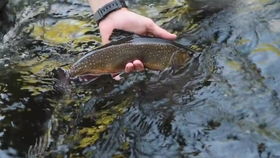The Art of Trout Fishing: Effective Techniques to Lure Fish in Stream Waters
Trout fishing, with its serene surroundings and the thrill of the catch, is a beloved pastime for anglers around the world. Whether you're a seasoned fisherman or a beginner, mastering the techniques to lure trout in the flowing waters of a stream can significantly enhance your fishing experience. In this article, we will delve into the intricacies of stream trout fishing, focusing on the art of诱鱼技巧 (yòuyú jìqiǎo) that can help you become a more successful angler.
Understanding Trout Behavior in Streams
Before we delve into the techniques, it's crucial to understand the behavior of trout in stream environments. Trout are known for their selective nature and can be quite elusive. They tend to be more active during the early morning and late evening, with midday being the least productive time. Additionally, trout are highly sensitive to water temperature and movement, so finding the right spot and timing is key.
Choosing the Right Equipment
The first step in trout fishing is to ensure you have the right equipment. Here's a rundown of the essential gear:

Rod and Reel: A lightweight, flexible rod with a fast-action tip is ideal for trout fishing. A matching reel with a smooth drag system is also important to handle the light line and delicate presentations.
Line: Use a monofilament line with a breaking strength of 4 to 6 pounds. Fluorocarbon line is a popular choice due to its low visibility in water.
Leaders and Tippets: Leaders should be around 9 to 12 feet long, with a tippet of 6 to 12 inches. This allows for a natural presentation and reduces the risk of the trout seeing the line.
Hooks: Small hooks, typically sizes 8 to 14, are best for trout. The size depends on the bait you're using and the size of the trout you're targeting.
Bait and Lures: Natural baits like worms, nymphs, and streamers are effective, as are artificial lures like spinners, spoons, and flies.
Techniques to Lure Trout in Streams
Now that you have the right equipment, let's explore some effective techniques to lure trout in stream waters:
Spot Selection:
- Current Lines: Trout often hold in the seams where the current is slower, such as along the edges of rocks or in pools. Look for these areas as they are prime spots for trout.
- Deep Holes: Trout may seek shelter in deeper holes during hot weather. These spots can be productive, especially in the middle of the day.
- Structure: Look for areas with natural structure like fallen trees, rocks, or logs, as they can provide cover and attract trout.
Presenting the Bait:
- Dead Drift: For natural baits, a dead drift presentation is often effective. Let the current carry your bait naturally through the water, mimicking the movement of real insects or worms.
- Worming: If you're using worms, a steady, slow retrieve can be effective. Allow the worm to bounce off the bottom and into the current.
- Streamers: For streamers, a lively retrieve with a variety of strokes can imitate the movement of small fish or insects. Experiment with different retrieves to see what works best.
Timing and Patience:
- Early Morning and Evening: Trout are most active during these times, so fishing during these periods can yield better results.
- Patience: Trout can be picky, so it's important to be patient. Wait for the perfect moment to cast or make a presentation.
Reading the Water:
- Water Flow: Observe the water flow and adjust your casting angle accordingly. Cast into the current, not against it, to achieve a more natural presentation.
- Water Clarity: In clear water, trout are more cautious, so a more delicate presentation is required. In murky water, you can be a bit more aggressive.
Adaptability:
- Weather Changes: Be prepared to adapt your techniques based on weather changes. On hot days, trout may seek cooler water, so consider targeting deeper holes or areas with shade.
- Seasonal Changes: Adjust your bait and techniques according to the season. In the spring, look for emerging insects, while in the fall, fish may be more interested in larger food sources.
Conclusion
Trout fishing in streams can be a challenging yet rewarding experience. By understanding trout behavior, selecting the right equipment, and employing effective techniques, you can increase your chances of success. Remember, the key to successful trout fishing is patience, observation, and adaptability. With practice and experience, you'll become a more skilled angler, able to navigate the complexities of stream trout fishing and enjoy the beauty of the water's edge.












